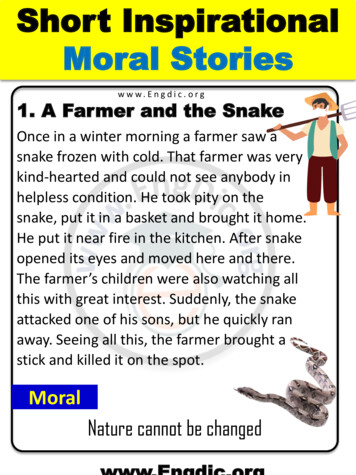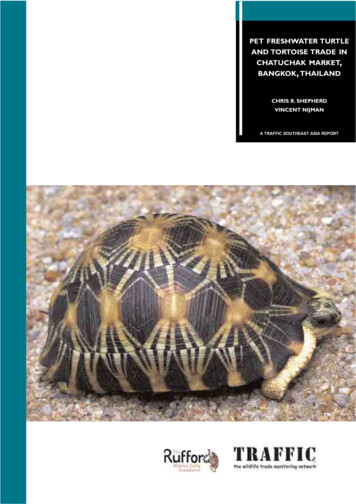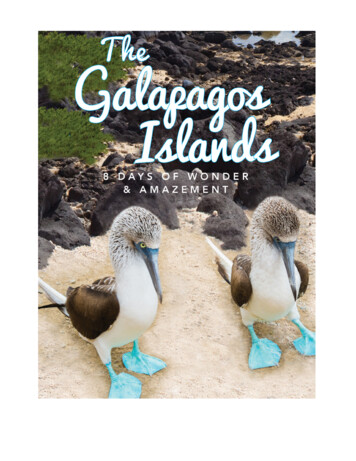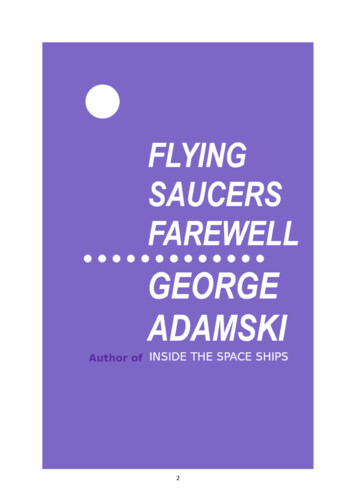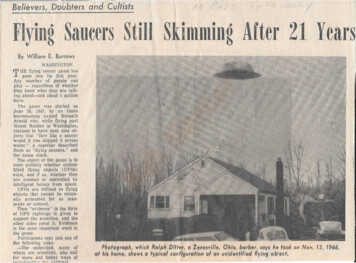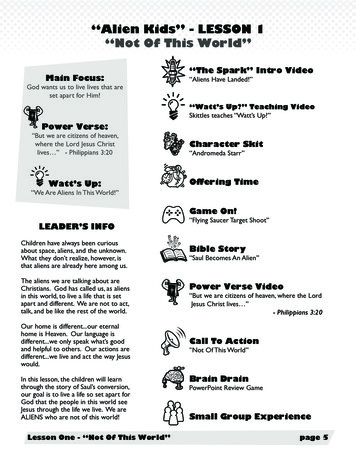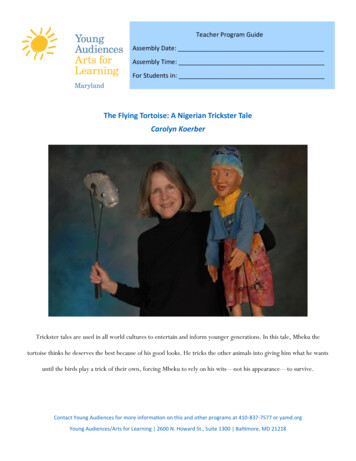
Transcription
Teacher Program GuideAssembly Date:Assembly Time:For Students in:The Flying Tortoise: A Nigerian Trickster TaleCarolyn KoerberTrickster tales are used in all world cultures to entertain and inform younger generations. In this tale, Mbeku thetortoise thinks he deserves the best because of his good looks. He tricks the other animals into giving him what he wantsuntil the birds play a trick of their own, forcing Mbeku to rely on his wits—not his appearance—to survive.Contact Young Audiences for more information on this and other programs at 410-837-7577 or yamd.orgYoung Audiences/Arts for Learning 2600 N. Howard St., Suite 1300 Baltimore, MD 21218
Teacher Program GuideAssembly Date:Assembly Time:For Students in:Please pass along the attached teacher program guide to all participating classrooms.Setup Requirements School contact to meet artist upon arrival and direct to performance site, help with lighting, etc Artist will arrive 45 minutes prior to performance time. Please have someone assigned to assist in unloading andloading equipment. Please supply a flat cart, if no one is available. Cleared indoor performance area, away from interference and noise Performance area 12 feet by 12 feet and 8 feet high If performance is on stage, children should be on chairs. If on the floor, children should be seated on the floor.Artist Arrival Time45-60 minutes prior to performanceSuggested Introduction“Ladies and Gentlemen, Boys and Girls, I am very excited to present Ms. Carolyn Koerber!”Inclement WeatherDON’T WORRY! Artists will follow school closings and delays and will work with you to reschedule the performance ifnecessary.Young Audiences Contact Number410-837-7577Artist Contact Information410.357.5846 or 443.866.6094puppetfactory@comcast.netAfter Hours / Emergency NumberCall 410-837-7577 and follow the prompts to be connected with a staff member on call.Contact Young Audiences for more information on this and other programs at 410-837-7577 or yamd.orgYoung Audiences/Arts for Learning 2600 N. Howard St., Suite 1300 Baltimore, MD 21218
Teacher Program GuideAssembly Date:Assembly Time:For Students in:Artist BioInside this Guide: Artist Bio andStatementProgramDescriptionMaryland StateCurriculumConnectorsCore yList of ResourcesPre- and n Koerber, founder of the Puppet Factory, has been involved in teaching, acting and directing since 1967. She hasworked in summer stock theatre, educational films, and public television and has taught creative drama and puppetry tochildren and adults in schools, libraries, theatres and recreation centers. Since 1970, she has taken her puppetproduction and residencies to schools, libraries, theatres, and other organizations throughout the Mid-Atlantic area.Artist Statement“As a storyteller, puppeteer and teacher, I seek to present performances of high quality, honestly and with a sense ofhumor. I try to achieve a link between audience and performer that allows both to grow and learn.”Contact Young Audiences for more information on this and other programs at 410-837-7577 or yamd.orgYoung Audiences/Arts for Learning 2600 N. Howard St., Suite 1300 Baltimore, MD 21218
Teacher Program GuideAssembly Date:Assembly Time:For Students in:Program DescriptionTrickster tales are used in all world cultures to entertain and inform younger generations. In this tale, Mbeku thetortoise thinks he deserves the best because of his good looks. He tricks the other animals into giving him what he wantsuntil the birds play a trick of their own, forcing Mbeku to rely on his wits—not his appearance—to survive.“What impressed us the most was Carolyn’s ability to bring out the creativity in our students.”Brian, Teacher, Harford Day SchoolContact Young Audiences for more information on this and other programs at 410-837-7577 or yamd.orgYoung Audiences/Arts for Learning 2600 N. Howard St., Suite 1300 Baltimore, MD 21218
Teacher Program GuideAssembly Date:Assembly Time:For Students in:Maryland State Curriculum ConnectorsMaryland State Curriculum Standards For Fine Arts:Standard 2.0 Historical, Cultural, and Social ContextStudents will demonstrate an understanding of visual arts as an essential aspect of history and human experience.Common Core Standard ConnectorsRL.3.1 Ask and answer questions to demonstrate understanding of a text, referring explicitly to the text as the basis forthe answersRL.3.3 Describe characters in a story and explain how their actions contribute to the sequence of eventsContact Young Audiences for more information on this and other programs at 410-837-7577 or yamd.orgYoung Audiences/Arts for Learning 2600 N. Howard St., Suite 1300 Baltimore, MD 21218
Teacher Program GuideAssembly Date:Assembly Time:For Students in:Background InformationThe story, The Flying Tortoise, comes from the Igbo people of southeastern Nigeria in West Africa, in an area the size ofSwitzerland. Storytelling is a very important part of their culture. Stories are told at night for entertainment as well asinstruction, often with the entire community involved in the telling. These are performances through which the tribe cancelebrate its identity as a group by sharing stories. Through storytelling, they pass on information, from generation togeneration, about the history of the tribe. They also teach children lessons in the mortality and values that are importantto the Igbo people.Stories such as The Flying Tortoise show how a trickster or a hero uses his wits to get something he wants, or how he isfrustrated by the acts of someone who is bigger, stronger, or more clever than he is. Many African trickster tales areabout small creatures who live in the nooks and crannies of the world, and who maintain a kind of natural wildness.Through these tales, the people hold onto a feeling of kinship with animals and a sense that animals, who are wiser thanhumans, can teach humans how to live on the Earth and how to behave.One important way in which a good storyteller is judged is through his or her ability to imitate animal speech. In animaltales, each animal is given a distinctive voice that readily identifies it to the listeners. In my turtle tale, I use my vocalskills to create special voices for Mebku, Ngwele, and Parrot.African trickster tales are quite different from the “Once upon a time happily ever after” folktales of Europe. The maincharacter often doesn’t succeed, but learns to deal with the way things are. These tales explain a reason for something- inthis case, why the turtle shell is not smooth but bumpy. They dramatize a moral. Greedy turtle manages to trick the birdsout of all the food, but for his selfishness he is punished. His shell is broken into pieces. The main character is naughty butis forgiven. In this case, the lizard makes Mebku a new shell.Mebku, the turtle, is a very popular trickster among the Igbo. He is always making mischief to make things go his wayand he always makes things happen, for better or worse! He gets into trouble because of his selfishness, love of food, andoverconfidence and other animals make fun of him when he fails. His problems teach children how to behaveappropriately within the society. But there is another side to the lesson. This trickster is smart, funny and very good atfinding ways to get what he wants. It is a celebration of determination and ingenuity.Contact Young Audiences for more information on this and other programs at 410-837-7577 or yamd.orgYoung Audiences/Arts for Learning 2600 N. Howard St., Suite 1300 Baltimore, MD 21218
Teacher Program GuideAssembly Date:Assembly Time:For Students in:Vocabulary Igbo: ethnic people of Southeastern Nigeria Nigeria: a country in the Northwest part of Africa Trickster: a mischievous or roguish figure in myth or folklore who typically makes up for physical weakness withcunning and subversive humor. The Trickster alternates between cleverness and stupidity, kindness and cruelty,deceiver and deceived, breaker of taboos and creator of culture. Skyland: according to many African and Native American tribes, Skyland is a separate world that exists in theclouds and looks just like Earth Lizard: retile living on all continents, except AntarcticaList of ResourcesBOOKS Puppetry In Early Childhood Education by Nancy Renfro and Tamara Hunt The Flying Tortoise, An Igbo Tale by Tololwa M. Mollel. Clarion Books; New York, NY; 1994. The Complete Book of Parrots by Rosemary Low. Barron’s Educational Series, Inc.; Hauppauge, NY; 1988. Turtles by John M. Mehrtens. T.F.H. Publications, Inc.; Neptune City, NJ; 1984.WEBSITES This link from Encyclopedia Britannica offers a wealth of information about the concept of trickster tales. The sitegives a detailed explanation, along with examples from different countries and famed authors. A greatpre-performance resource! rickster-tale This is the official website of the Nigerian government. On this site you will find current events, beautiful photographs, information about the Nigerian people, and many other informational sources:http://www.nigeria.gov.ng/ This link from Encyclopedia Britannica offers information about the Igbo people of southeastern Nigeria. It outlinesthe history and culture: gboContact Young Audiences for more information on this and other programs at 410-837-7577 or yamd.orgYoung Audiences/Arts for Learning 2600 N. Howard St., Suite 1300 Baltimore, MD 21218
Teacher Program GuideAssembly Date:Assembly Time:For Students in:Pre-Performance Activities It is highly recommended by the artist that the classroom teacher familiarize students with both the story as well as thevocabulary pertinent to this performance. This will add to their understanding and appreciation for the performance. Find Nigeria on a map of Africa. Look for the Southeastern sections where the Igbo people live. What is the land likethere? What animals might you find in this part of Africa?What is a trickster tale? What animals are usually the tricksters in African stories? (Anansi the Spider, Mbeku the Turtle, rabbit). How is a trickster tale different from a “happily ever after” European folktale? What lessons do childrenlearn from a trickster tale?Why is storytelling such an important part of the lives of Igbo people? Why do they tell stories? Use the link from Encyclopedia Britannica as a resource.Read an African trickster tale. Discuss the lessons learned from the story. Post-Performance Activities 1.2.3.Vocabulary Activities:Read some African trickster tales and discuss the character of the trickster. Paint a picture using words. Use adjectivesand adverbs to paint an interesting character.Writing Activities:Imagine you are the Queen of Skyland. Write a letter to a friend describing what happened when that trickster turtlecame up to Skyland. Imagine you are the Parrot. Write a letter to the editor of a newspaper telling them that you aresick and tired of being tricked by Mbeku and what you think ought to be done about it.Make an outline of the story, “The Flying Tortoise”: Decide how many sections or scenes are in the story Begin the outline by stating the problem or conflict Add the main actions that lead to the climax of the story Decide where the climax comes in the story Finish with how the problem needs to be solvedWrite an alternate ending to the story, “The Flying Tortoise.” Use “what would happen if ” to change the directionof the story.Contact Young Audiences for more information on this and other programs at 410-837-7577 or yamd.orgYoung Audiences/Arts for Learning 2600 N. Howard St., Suite 1300 Baltimore, MD 21218
Teacher Program GuideAssembly Date:Assembly Time:For Students in:Discussion Questions1. What kinds of puppets were used in “The Flying Turtle”? Who made the puppets? What materials were used to makethe puppets? How was each puppet held and moved? Which puppet was a hand-and-rod puppet? (parrot) Which was asimple rod puppet? (the little bird) Glove puppets? (Mbeku the turtle and Ngwele the lizard) How did Carolyn decidehow she would hold and move each puppet?2. How did Carolyn create the following special effects? Mbeku’s wings flapping Parrot ripping apart Mbeku’s wings The shell breaking into “a thousand pieces” Mbeku pulling his head and legs “inside” his shellContact Young Audiences for more information on this and other programs at 410-837-7577 or yamd.orgYoung Audiences/Arts for Learning 2600 N. Howard St., Suite 1300 Baltimore, MD 21218
Sample Lesson PlanYOUNG AUDIENCES OF MARYLANDLesson Title: Identifying CharacterArtist’s Name: Carolyn KoerberTeacher’s Name:School:Grade:Fine Arts Standard:Standard: 2.0 Historical, Cultural, and Social ContextIndicator: 1. Determine ways in which works of art express ideas about self, other people, places, andeventsObjective: b. Use selected works of art as inspiration to express ideas visually and verballyIntegrated Content Area:RL.3.3 Describe characters in a story (e.g. their traits, motivations, or feelings) and explain how theiractions contribute to the sequence of events.Lesson Objective: Students will analyze character by discussing words and actions to identify charactertraits.Introduction/ Motivation (10 minutes)Question the students: How do we analyze character? What do we need to do figure out what someone islike? Is it what they say? What they do? How they treat others? How do you really know what a person islike? Discuss as a whole group.Develop a web on the SMART board or the chalkboard/ whiteboard with the ideas you discussed as agroup.Modeling (10 min):Say to the group: We are going to try and figure out what the characters from the story: “The FlyingTortoise” are really like. We are going to use their thoughts, words, and actions to decide.Display the text on the overhead or SMART board. Start to read the text to the students, modeling fluencyand expression. This text can be found in the resources section at the end of this lesson.After reading the first paragraph, say: I notice that the text says the turtle loved to look at his reflection inthe pools of water. It also says that when he wasn’t admiring his reflection, he was tricking others.Think aloud: It seems to me that he is pretty vain. He loves to look at himself in pools of water. He seemsto think very highly of himself.
Guided Practice (10 min):Read the next section/ paragraph to the students: What are you noticing about Mbeku? What are hisactions telling you about him? How is he treating others?Allow students to come up with different adjectives to describe Mbeku.Question the students: Why would you use that adjective to describe Mbeku? What proof from the text doyou have to justify those descriptions? Students will need to pull information directly from the text.For example: Mbeku is jealous of parrot. In the text it said that he persuaded his friend, Lizard to make himwings because he did not want to miss out on the fun and food. This was after Parrot was bragging aboutgoing to the feast.Independent Practice (5-7 min):Release the process to the students. Say: Read the next two paragraphs to yourself. How else could youdescribe Mbeku? What do his words and actions say about his character?Give students 5 minutes to read and jot down a few notes about character. They can use a post-it note aswell.Assessment/Closer (10 min):Discuss thoughts as a whole group. Question students: How else can we describe Mbeku? Students willshare what they jotted on their post-it note. Encourage students to pull evidence directly from the text tosupport their choice of character trait.Extension: Read through a second time to determine character traits for other characters in the story.Vocabulary:Igbo- ethnic people of Southeastern NigeriaNigeria- country in the Northwest part of AfricaTrickster- a mischievous or roguish figure in myth or folklore who typically makes up for physical weaknesswith cunning and subversive humor. The Trickster alternates between cleverness and stupidity, kindnessand cruelty, deceiver and deceived, breaker of taboos and creator of culture.Skyland- according to many African and Native American tribes, Skyland is a separate world that exists inthe clouds and looks just like EarthLizard- retile living on all continents, except AntarcticaMaterials:Copies of the story “The Flying Tortoise,” one for each student and one for the overheadPost-it notesSMART board or overhead/ document cameraProjectorHandouts:Copy of the story: “The Flying Tortoise” for each student
“The Flying Tortoise”Long ago, the first turtle, Mbeku, had a bright, golden gleaming shell. He loved to look at hisreflection in the pools of water. When he wasn’t admiring his handsome shell, he was busytricking other animals. He thought he was so wonderful that he deserved the best of everythingand would trick the other animals into giving him their food.One day, he saw his friend Parrot laughing and dancing in a clearing. Parrot explained that heand all the other flying Earth dwellers were invited to a big feast by the Queen of Skyland. Mbekusaid that he should go too, but Parrot said that was impossible because he had no wings to fly toSkyland. Mbeku persuaded his long-suffering lizard friend, Ngwele, into making him a set of wings.He didn’t want to miss out on all the food. When the wings were strapped on, Mbeku thought helooked more handsome than before. After a few false starts, he flapped his “wings” and up, up, uphe went above the clouds to Skyland.The Queen of Skyland was very excited about the visitors who were coming from Earth. Shebrought out enough food for all of the flying Earth Dwellers (or so she thought). She greeted herfirst visitor, who just happened to be Mbeku. He quickly introduced himself as the King of All theEarth Dwellers and explained that the king always eats first. Diving into the food, he didn’t stopuntil there was nothing left but rinds, stems and peels.As Mbeku lay resting, along came Parrot with a big appetite. He took one look at the mess andknew that Mbeku had eaten all the food. Furious, he stomped on the feathers until the wingswere destroyed. Mbeku had to think fast or he would be stuck forever in Skyland. He beggedParrot to tell Ngwele to pile up leaves and soft grasses for him to land on. At first he refused, butTrickster Mbeku assured him that if he would help him, he would never trick the other animalsagain. But when Parrot had gone, a little bird heard Mbeku laughing and congratulating himself onthe neat trick he played on Parrot. The little bird hurried to tell Parrot who decided that he wouldplay a trick of his own. Parrot flew off to Earth where he persuaded Ngwele to pile up the sharpestrocks she could find. Ngwele did not understand, but she did what she was told.While Mbeku waited to jump, Ngwele gathered the sharpest rocks she could find. From Skyland,Mbeku thought he saw a soft pile of grasses, took aim, and jumped. Crash! He landed on the sharprocks and broke his beautiful shell into a thousand pieces. When he saw his reflection in the poolof water, he couldn’t believe his eyes. He quickly hid behind a clump of ferns and begged Ngweleto fix his shell. This wasn’t possible because the shell was smashed.Ngwele felt sorry for him and did her best to make him a new shell out of bits of stone. When itwas done, Mbeku tried it on and hurried to the water’s edge to admire it. He was shocked at whathe saw- a dull, ugly, bumpy shell. He was so embarrassed he did something he has never donebefore- he pulled his head and feet into his shell and stayed that way all day.In the morning, Parrot came looking for him. He stood right up on top of Mbeku’s new shell,saying “Hmm, I wonder where that old trickster could be. Nothing here but this rock. Well, hewon’t bother me for a long, long time.” Parrot walked off chuckling and thinking that he hadfinally out-tricked the trickster. He was so busy laughing that he didn’t notice when a certain“rock” began laughing too. Mbeku had learned that camouflage can be a trickster’s best friend!
came up to Skyland. Imagine you are the Parrot. Write a letter to the editor of a newspaper telling them that you are sick and tired of being tricked by Mbeku and what you think ought to be done about it. 2. Make an outline of the story, "The Flying Tortoise": Decide how many sections or scenes are in the story


